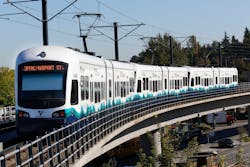It was 8:45 p.m. on election night. The air was thick with anticipation as transit agency leaders, elected officials and community advocates anxiously paced awaiting the first results of a $54 billion transit expansion measure in the Seattle region. The results, which were already 30 minutes late, finally appeared in a hard-to-read text file, adding to the chaos and confusion. Did we win? Was it close? It was hard to tell with all the number flying around.
“Read me the numbers!” I shouted, grabbing a laptop to tally the results. As I read the results aloud, people started to cheer. It took me a moment but it finally dawned on me that it was over. We had finally won. After 50 years of waiting, the Seattle region was finally going to build the rail system it deserved.
This win couldn’t have come at a more urgent time. The Puget Sound region has experienced rapid growth in the last few years, as more people choose to live and work here. And we are expected to grow by nearly a million people in the next several decades. With this growth comes immense traffic challenges. Congested roadways make it impossible to reliably navigate our city and the region by car. Getting to work in the morning only a few miles away can take over an hour. Our robust bus systems are in high demand. They serve us well but it only takes a crash or a fish truck turning over and the entire city to grinds to a halt.
This victory was a long time coming. The Seattle history books are filled with stories of transit failures from long before many of us were born or moved here. Most memorably, voters a half century ago rejected an expansive subway system that would have received significant federal funding. In the years that followed, nearly every decade included an attempt to build the grade-separated system we need now. But in 1996, voters approved of the creation of Sound Transit, the regional transit authority laying the ground work to build and operate a full-scale mass transit system.
Sound Transit currently operates regional commuter trains, a regional bus system and 20 miles of light rail. An additional 30 miles of light rail are planned or under construction. As every light rail station opens, Sound Transit ridership continues to grow.
This has been an excellent start, but it is not enough to meet the demands of the region. To plan for the growth that we are expecting and the traffic congestion we are experiencing, Sound Transit leadership spent three years developing the next phase of expansion fighting political battles to obtain the authority to raise taxes. Last June, after years of process, including extensive public outreach, the Sound Transit board voted to send a $54 billion package to the voters that would add 62 miles of light rail to our growing transit system that will eventually complete a 116-mile light rail network as well as bus rapid transit, commuter rail and express bus service. The final step was to convince over 50 percent of our 1.6 million voters to vote "Yes."
Sample promotional material at MassTransitmag.com/12303679
And we did. I think we were successful on election night because of the following:
We went big.
Sound Transit put forward a bold and visionary package based on constituent feedback. Many critics, including the Seattle Times, argued that we were pushing a package that was too big. However, a smaller investment would have meant a less expansive transit system therefore a less compelling reason for voters to say "Yes." Residents from all across the region could finally see themselves using the system and how they would get around. After a half-century of dragging our feet, this region was ready to be bold.
We built broad and strong coalitions.
Transit has a way of bringing people together: the business community, environmentalists, social justice advocates, housing advocates, community organizations, and labor. We spent years cultivating strong relationships with a broad set of stakeholders who recognized the important intersectionality of transit and their work. Our partners had a place at the table to help craft the package and direct the campaign. And our partners showed up big time, from being our spokespeople to knocking on doors. The diversity of perspectives in developing and promoting the measure was critical to our success.
We understand our voters and prioritized our resources.
Research was an essential part of our victory — polling helped us get feedback, craft our message and use every penny well. Voter turnout in general elections in Washington State is very high and there was no way we would be able to communicate with all 1.6 million voters within the district. We researched and strategically communicated with “swing” voters or voters who were on the fence about this issue. We were confident that if they heard our messages, they would likely vote "Yes."
Strong advocacy groups matter. We would not have won without the support and long-term efforts of advocacy organizations like Transportation Choices, a statewide education, policy and advocacy organization working to advance public transit in Washington State for the last 25 years. Transportation Choices spent years developing effective messaging and strong relationships with elected officials, transit agencies and community organizations. It was essential that these groups provided grassroots support.
Decades of work and determination went into our victory last November and decades of work remains to ensure we build a mass transit system that works for all in our community. This victory would not have been possible without strong community leaders, elected officials, and broad-based coalitions who fought time and time again to get our region the mass transit system we need.
Abigail Doerr is the advocacy director at Transportation Choices and was the campaign manager for the successful Mass Transit Now campaign which approved the $54 billion Sound Transit Proposition 1 in the Puget Sound.
